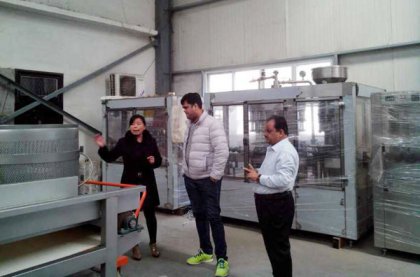Food quality and hygiene are most directly related to sterilization equipment, and self-sterilization of food is also called internal contamination control. For solid food, liquid food, powder food and meat products, the hot sterilization technology and equipment are mainly as follows.
Popular sterilization technology and equipment
Microwave sterilization
Microwaves are electromagnetic waves with frequencies ranging from 300MHz to 300GMHz. The interaction between microwave and material directly transforms the UHF electromagnetic wave into heat energy. Microwave sterilization is the result of the combined effect of microwave thermal effect and biological effect. The potential distribution of microwave on the cross-section of bacterial membrane affects the concentration of electrons and ions around the cell, thus changing the permeability of the cell membrane. Bacteria are malnourished, can not metabolize normally, growth and development are hindered and die. From the biochemical point of view, the normal growth and reproduction of bacteria nucleic acid (RNA) and deoxyribonucleic acid (DNA) is a number of hydrogen bonds tightly linked to form a convoluted macromolecule, microwave leads to hydrogen bond relaxation, breakage and reorganization, thus inducing genetic or chromosomal aberration, or even breakage. Microwave sterilization is the use of electromagnetic field effect and biological effect to kill microorganisms. Microwave equipment has obvious advantages in sterilization temperature, sterilization time, product quality maintenance, product shelf life and energy saving. It is suitable for packaged bread, jam, sausages, pancake, dessert, and insecticide and eggs in storage.
Autoclaving technology
The process of killing microorganisms in food by putting food in a liquid medium and adding pressure of 100 MPa-1000 MPa for a period of time, just like heating. High pressure sterilization avoids the malpractice of heat treatment, and keeps the original flavor, color and nutritional value of food. Because it is the instantaneous compression process of liquid medium, sterilization is uniform and pollution-free. The operation is safe. Compared with the heating method, the energy consumption is low and the environmental pollution is reduced. It is suitable for processing meat, egg, soybean protein, fruit, spice, milk, juice, mineral water, beer and so on.
Pasteurization
Pasteurization refers to the low temperature heat treatment method, which uses hot water as the heat transfer medium. The sterilization condition is 61-63℃, 30 min; or 72-75℃, 10-15 min. When heating, it should be noted that the surface temperature of the material is 4-5 ℃ below the internal temperature. Due to the shorter shelf life, longer production time, discontinuous production process, and long heating time, pasteurization is generally suitable for fresh milk production enterprises.
Low temperature sterilization
Low temperature sterilization is a partial sterilization method for microorganisms in food. The temperature below 100 ℃ is usually used. After cold sterilization, there are more bacteria in food. In order to prolong the shelf life of the products, the processing technologies such as refrigeration, fermentation, adding additives and deoxidization are used. This method is mainly suitable for acidic food with pH below 4.5 and food with strong heat treatment which will obviously lead to quality degradation. In recent years, this method has also been applied to milk and short shelf life commodities.
Ultra high temperature instant sterilization
Ultra high temperature instant sterilization is called UHT sterilization. UHT sterilization is a process in which the heating temperature is 125-150 ℃ and the heating time is 2-8 s. The sterilization method can achieve the goal of sterilization in an instant. The sterilization effect is especially good. It can almost reach or approach the sterilization requirement, and the chemical change caused is very small. It can improve the processing capacity, save energy, reduce the size of equipment, stabilize product quality, and implement in-situ non-disassembly cycle cleaning of equipment. Today, it has developed into a new technology for sterilization of high and new foods.


